
- Home
- Artist
- David Bates (3)
- David Snyder (4)
- F E. Jamieson (3)
- Francis E. Jamieson (3)
- Giovanni Demartino (3)
- Illegible Signature (10)
- Jean-michel Basquiat (3)
- John S. Barrows (4)
- Keith Haring (2)
- Lovejoy (3)
- Morgan (2)
- Mystery Artist (6)
- Otterman (3)
- Pablo Picasso (15)
- Remedios Varo (4)
- See Description (30)
- See Photos (3)
- Signed (4)
- Signed On The Back (2)
- Unknown (42)
- ... (4675)
- Material
- Signed
- Title
- Type
- Acoustic (9)
- Baskets (9)
- Bowls (11)
- Boxes (46)
- Furniture (14)
- Kitchen Equipment (25)
- Marquee Sign (13)
- Metal & Ironwork (31)
- Painting (190)
- Paintings (14)
- Plaque (20)
- Plaques / Signs (18)
- Pottery (13)
- Print (22)
- Sculpture (13)
- Sign (45)
- Signs (76)
- Street Sign (19)
- Tools (11)
- Wooden Sign (9)
- ... (4216)
- Unit Of Sale
Antique Old PRIMITIVE American Folk Art Outsider GAME BOARD, Backgammon 1920s
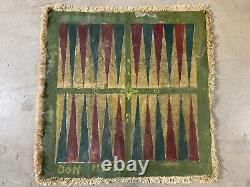
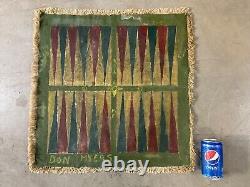
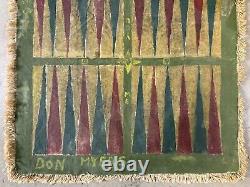
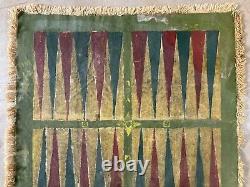
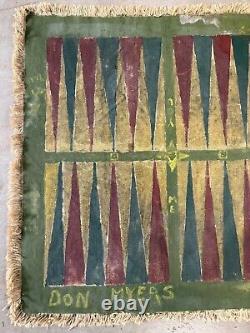
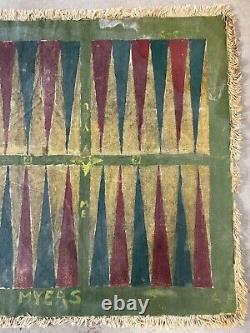
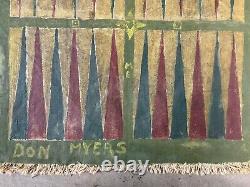
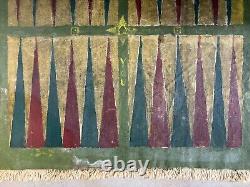
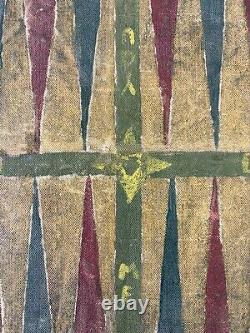
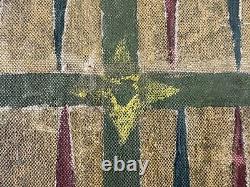
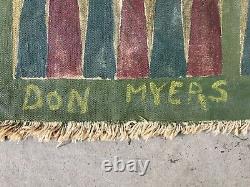
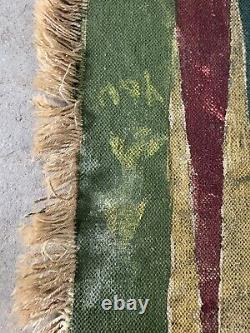
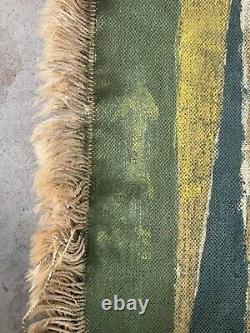
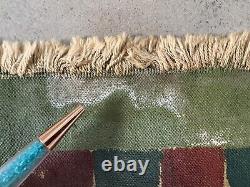
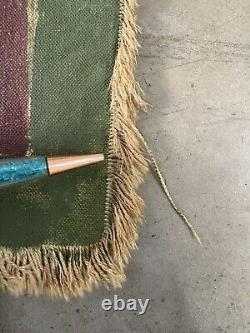
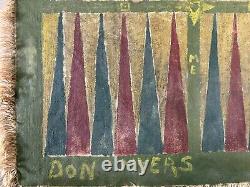
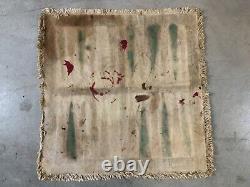



This is a wonderful and unusual Antique Old PRIMITIVE American Folk Art Outsider GAME BOARD, Oil on Canvas, depicting a curiously rendered Backgammon board, with crude directionals, handwriting and arrows indicating "YOU" and "ME" in various areas. The overall game board is painted with an olive-green color, and the handwriting is in yellow paint. The gaming areas are painted in forest green, beige and burgundy hues. This piece is curiously signed: "DON MYERS" in the lower left corner.
I could not find any information on this artist and Backgammon player, but perhaps you know more about them or their work? This piece likely dates to the 1920's - 1930's.
Approximately 18 1/2 x 18 1/2 inches not including fringe. Good condition for age, storage, and frequent gaming use, with mild - moderate scuffing, scratches, and areas of paint loss and soiling throughout please see photos. Acquired from an old estate collection in Los Angeles County, California.
If you like what you see, I encourage you to make an Offer. Please check out my other listings for more wonderful and unique items! AMERICAN GAME BOARDS, 1880 - 1940. Aligning with Ricco/Maresca's ongoing mission to promote the crossover of self-taught, outsider, and vernacular art into the modern and contemporary arenas, Play presents a collection of outstanding game boards made between the late 19th century and the first half of the 20th century. Created as functional objects by unknown American artists, these examples of parcheesi, backgammon, halma, checkers, Chinese checkers, mills, and solitaire have transcended their original purpose and stand on their own as cousins of modern art. This exhibition thus decontextualizes these works to highlight their concrete beauty, but it also acknowledges the mystery and gravitas that they possess as objects that once participated in everyday life. Modern board games developed as a result of the Industrial Revolution and the emergence of the middle class, but their precursors date back to ancient times-with dice being at the core of humanity's oldest games.The most prolific and creative period in the American game board tradition falls approximately between 1820 and the end of World War II, when a general period of prosperity and the mainstream availability of new technologies, particularly radio and television, practically eliminated people's need to fabricate the means to entertain themselves. In the nineteenth century, the majority of game boards were homemade for personal use or produced in domestic workshops for sale within the immediate community-much in the same way as bird decoys, dolls, and quilts.
Artists used the materials at hand; easily accessible, generally native hardwoods and standard oil-based household paint-whose durability could withstand the continuous quiet abrasion of the moving parts on the surface. In the informal environment of a young American nation, artists transformed pre-established patterns into personal compositions, taking creative liberties analogous to jazz-if we think about the framework of the game as a basic melody and of each artist's visual execution as a kind of musical improvisation.
In the best of cases, game boards embody this powerful junction of familiar and new information; of tradition and innovation, with the latter manifesting itself through various degrees of abstraction, deconstruction, and formal embellishment or distillation. The rhythmic configurations in the square grids of checkers and halma boards; the flat architecture of parcheesi, with its four nests flanking a nucleus and divided by compartmentalized paths; the sharp hypnotic quality of backgammon's interweaving dagger-like triangles; the harmonious symmetry of the marble-shaped indentations of the hexagram in Chinese checkers and the octagon or cross in solitaire, and the web-like concentric lines in mills offer us-as contemporary viewers-a visual lexicon that is as cohesive and direct as the best works of minimalism and geometric abstraction, which they often precede. Beyond this, a game board's texture and materiality are equally relevant to its graphic qualities: the surface and "purity" of the object should be a matter of historical significance, a threshold to its former life. Time becomes tangible through scratching from years of touch and play; through the network of cracks (or craquelure) triggered by the shrinkage of the paint and wood, and through the oxidation of the paint after the initial drying phase, which gives the pigments an aged, subdued quality. Play is Ricco/Maresca's first exhibition exclusively devoted to an art form that it has been passionately advocating for 40 years.
Our hope is that it contributes to bringing vintage American gameboards closer to entering the realm of fine art and further away from the notion of craft. The once marginal understanding of self-taught and outsider artists vis-à-vis the art historical continuum has changed radically in the last few decades, we now recognize them not as extraneous but as essential in the development and ethos of modern art; museums collect and present them. African American quilts have to a certain extent, and more recently, been included in this shift-with museums outside the folk art specialization collecting Gee's Bend quilts in particular. Exceptional works made by anonymous American game board artists must follow. The preface of Ricco/Maresca's book American Vernacular expresses it eloquently. It has been comfortable for dealers, critics, and collectors to champion this work under constricting labels, almost solely according to concepts of primitivism and authenticity. They set up a simple-and, we believe, spurious-opposition between vernacular and mainstream, art. We call this the'glass ceiling' of folk art, which forever limits its appreciation, understanding, and evaluation. Art is something people do all the time, everywhere, when they need to and when they don't, when others say it is wrong and when they say it is right. Whether art originated in private pain or in communal vision, it is always excessive.And excess, as William Blake taught, is a form of celebration. The curious histories behind board games, at the American Folk Art Museum. In this week's episode of.
Benjamin Miller speaks with Emelie Gevalt, curatorial chair for collections and curator of folk art at the American Folk Art Museum in New York. On view starting September 13 at the museum is the exhibition. Playing with Design: Gameboards, Art, and Culture. An exhibition co-curated by Gevalt, and she has brought along one special example to discuss: a nineteenth century painted-wood Game of the Goose board.American Folk Art Museum-Playing With Design: Gameboards, Art & Culture. NEW YORK CITY - On September 13, the American Folk Art Museum (AFAM) opens "Playing with Design: Gameboards, Art and Culture, " which follows a gift of gameboards and photographs from the collection of Bruce and Doranna Wendel that was announced by the museum in June 2024.
Celebrating not only the beauty of gameboards but also the greater cultural meaning behind them, the exhibition will showcase more than 100 gameboards from the Wendels' collection. It will feature early examples of classic games including Parcheesi, checkers and chess, as well as hand-painted iterations of some mid Nineteenth and early Twentieth Century games, such as Chutes and Ladders and Monopoly. Photographs depicting gameplay will round out the presentation. "The exhibition was prompted by more than the Wendels' gift, " as Emelie Gevalt, curatorial chair for collections, curator of folk art and the curator of "Playing with Design, " explains.There has not been a major exhibition on gameboards in many years, despite their popularity among collectors and their deep interpretive value as objects that speak to histories of American culture and daily life. The topic is not a new one, which Gevalt discusses in greater detail. The Wendels curated a gameboards exhibition for the American Folk Art Museum in the mid-1980s:'Winning Moves: Painted Gameboards of North America,' featuring boards from their own collection as well as others. In 1991 and 2003, the New-York Historical Society held two significant gameboards exhibitions that have contributed to the scholarship, although both focused on commercially produced boards.
Playing with Design' is the first show in many years to feature hand-painted gameboards. AFAM's connection to the collectors, familiarity with the material and mission "to showcase forms that are often overlooked in the context of the'fine art' canon" make it the ideal venue for the exhibition. "We provide a rich context for the discussion of gameboards as objects that were both functional and artistic, often homemade and used within a domestic or community setting, " noted Gevalt. She hopes the show will foster future study through technical analysis and greater documentation of the form.
The curator noted that a resurgence of gameplaying during the pandemic gave some urgency to explore tangible connections between the present moment and the material and creative vibrancy of the past. In preparing for the exhibition, there were both revelations and dispelled preconceptions for the curator.
Although boards are often assumed to be late Nineteenth and early Twentieth Century, folks were making hand-painted gameboards in the late Eighteenth and early Nineteenth Centuries. Although these are rarer to find, it is fascinating to see that Americans were fashioning their own gameboards even before the taste for gameplaying became popularized by mass production. She continued, The range of board types is truly astonishing - from bold, geometric examples that could easily find a place in a survey of Modern art, to highly personalized examples that speak to particular interests or relationships, like a masonic board painted with repeating death's heads and compasses, or a chessboard with sides allocated for husband and wife. "Though people have been playing games since ancient times, gameboards have been slow to gain recognition for their major contributions to human development, socialization and artistic expression, " said Gevalt. Because of the Wendels' special collection, we're able to examine how gameboards can provide deep historical insights into the values and priorities of American culture and creativity. She hopes viewers leave not only with a new appreciation for the "creative exuberance" of the form but are also inspired to think about how homegrown artistry might play a role in their own lives. Thematic sections divide the show, exploring ideas of craftsmanship, design, culture and history of game-playing in the United States. Some examples will remind viewers of familiar modern games, while others will give material shape to historical ideals, including morality, religion, patriotism, entrepreneurship and imagination. The gameboards on view will speak to underlying concepts of adventure and risk-taking as fundamental to life in the United States, proven through games organized around the themes of a train journey, a whaling expedition or a trip around the world.
